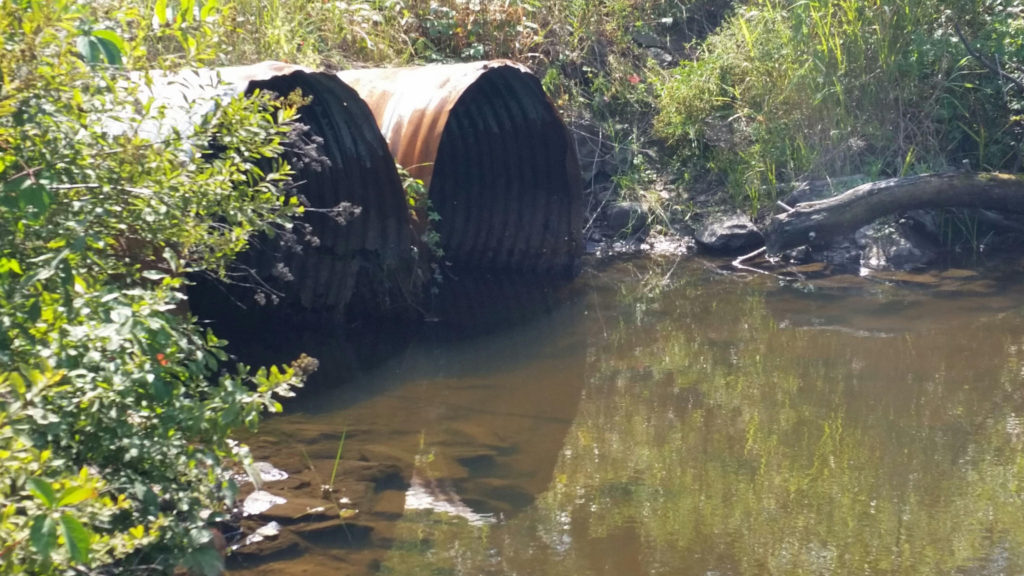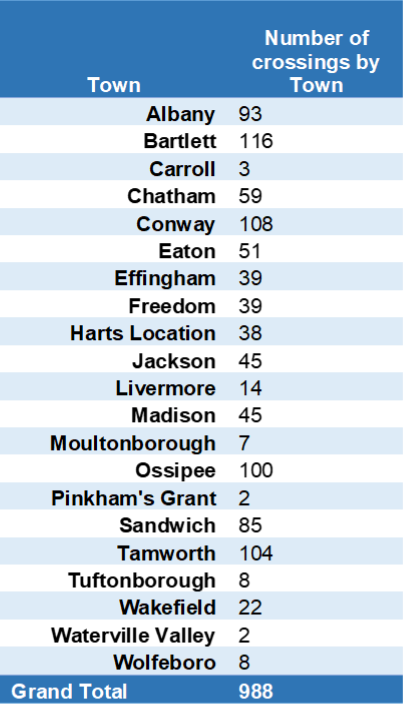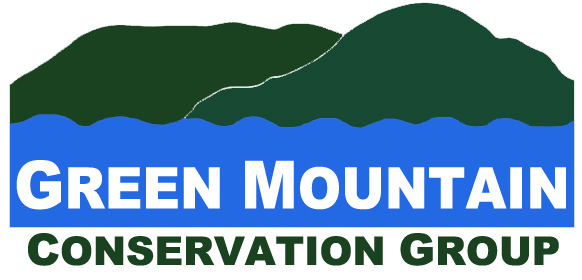GMCG SRSCAP Project Timeline
In 2023, GMCG’s goal is to work with local municipal agencies to determine next steps for culvert and stream crossing improvements.
In 2021, an additional 254 sites will be assessed: Madison (45), Sandwich (85), Tamworth (104), Effingham 1 (was under construction in 2020), Ossipee 10 (remote RR crossings, trails, QAQC site), Freedom 9 (1 under construction in 2020, 1 found at the end of the season, 7 in remote locations on trails).
In 2020, 146 sites were assessed in the towns of Effingham (37), Freedom (28) and Ossipee (81).
In 2022, GMCG assessed 105 crossings in the town of Sandwich, thanks to the efforts of local volunteers, staff and AmeriCorps members.
Sandwich (94), Tamworth (1), Ossipee (5), Effingham (2), Freedom (3).
Stream crossings refer to structures such as culverts and bridges that carry a road over a river, stream, wetland or other waterbody. The way these structures are built and how they function is essential to the health of a watershed, keeping water flowing and connecting lakes, ponds, rivers and streams. When they are clogged or improperly built or functioning, they can cause flooding, overtopping, erosion, pooling, a decline in water quality and also prevent wildlife from being able to move to critical habitat that they need to survive. They can also cause serious damage to roads, infrastructure and property while posing a safety hazard to the public. (See North Country Council’s Stream Crossing Guide for more information: http://bit.ly/nccSCGuide.)

Stream crossings should seem “invisible” in the stream, maintaining natural stream flows, depths, velocities upstream, downstream and within the structure itself. Poorly designed and underperforming structures can inhibit the ability of aquatic organisms such as fish, salamanders, frogs, turtles and invertebrates from being able to move to areas upstream or downstream. Wood, leaves and trash can clog undersized crossings, creating a barrier to water and wildlife and causing overtopping and flooding.
In addition, the expected increase in frequency and severity of flooding associated with climate change poses a very real threat that communities need to address in order to maintain a safe, healthy and resilient watershed, as well as prevent flood-related disasters that could negatively impact the region economically.
Beginning in the summer of 2020 GMCG staff, AmeriCorps members and volunteers performed field assessments of stream crossings in collaboration with partners at Hampshire Fish and Game Department, Saco Headwaters Alliance, North Country Council, Saco-Swift LAC, and Trout Unlimited, with support from New Hampshire Department of Environmental Services, New Hampshire Geological Survey, New Hampshire Department of Transportation, Natural Resources Conservation Service, New Hampshire Homeland Security & Emergency Management, and University of New Hampshire Technology Transfer Center. The trained teams used a statewide assessment protocol developed through the New Hampshire Stream Crossing Initiative. The multi-year project will consist of culverts assessments and fish community surveys in watershed towns, and will have long-term ecological, economical and social benefits to communities across the entire Saco River Watershed.

There are more than 20,000 stream crossings in New Hampshire, and it is estimated many of these structures (50-80%) may be in poor condition and in need of improvements based on watershed-scale crossing assessments that have been conducted previously by North Country Council, New Hampshire Fish and Game and Trout Unlimited , among others. The upper Saco River Watershed is the last major watershed in the state to be surveyed, representing a large gap in data and understanding of the condition of stream crossings (see NH Aquatic Restoration Web Mapper: https://bit.ly/2tXNoiq).

Table of stream crossings in the upper Saco River Watershed, credit Ashley Newell, Planning Technician for North Country Council.
There are estimated to be approximately 1,000 road-stream crossings in the upper Saco River Watershed that need to be surveyed, including crossing under roads, trails and railways. This is a major undertaking, as the Saco River Watershed is 1073 square miles in size, stretching from the White Mountains of New Hampshire and flowing to the southeast through Maine before reaching the ocean in Saco, Maine. New Hampshire’s portion of the watershed spans 869 square miles, crossing through portions of 32 communities in 3 counties. These many communities in New Hampshire and Maine depend on the health of the watershed for their drinking water, livelihoods, economies, health, recreation and quality of life.
Another aspect of the project will be the fish and macroinvertebrate community assessments conducted by New Hampshire Fish and Game. GMCG staff and volunteers will also assist with these surveys to enhance understanding of biological communities in local streams, and in particular, the distribution of Eastern brook trout, a species of greatest conservation need.
Since 2006, GMCG has worked with schools, local experts and volunteers to conduct the Volunteer Biological Assessment Program which examines macroinvertebrate communities in local rivers and streams following the same protocol that will be used by New Hampshire Fish and Game. This community science program’s historical data is also being used by the state for these surveys.
If you are interested in learning more about this project or participating in the surveys, please contact education@gmcg.org.
Saco River Stream Crossings Assessment Project Community Presentation from June 20, 2020
Additional Information
Here is an informational video about stream crossings:https://www.youtube.com/watch?v=aRskNkNgTkU&t=165s
More information about the NH Stream Crossings Initiative: https://www.des.nh.gov/organization/commissioner/pip/publications/documents/stream-crossings.pdf
Aquatic Restoration Mapper Manual: arm-mapper-manual.pdf (nh.gov)
Community Planning Guide: Stream Crossings, Flood Resiliency & Ecological Health: https://dev.nccouncil.
GMCG Saco River Watershed Stream Crossings Assessment Project Webpage: https://gmcg.org/

